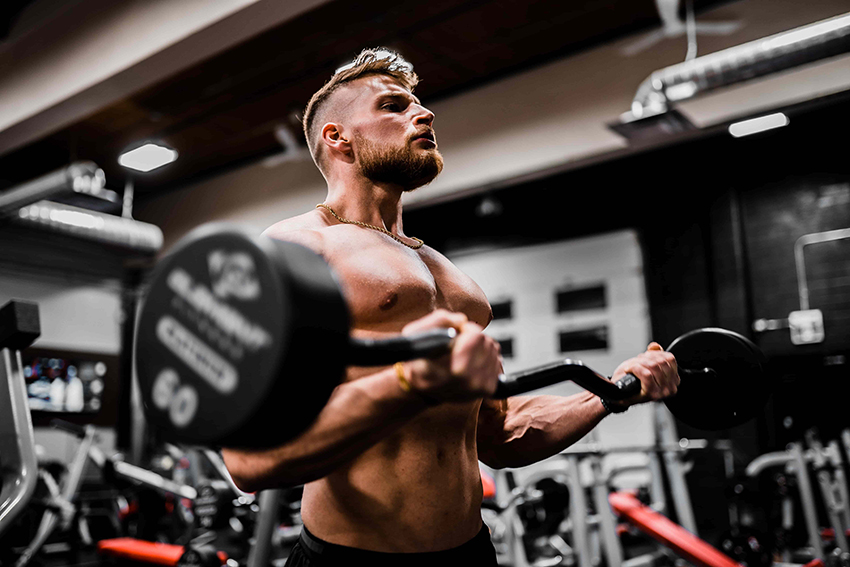Lifting weights for muscle growth can be confusing.
A muscular friend may tell you that five sets of incline bench press will build a massive chest. The latest Instagram post may recommend six weekly sets of preacher curls for huge biceps.
All you want to know is the best way to build muscle, but you don’t know who to believe.
So what do you do? You try out everything.
You try all the workouts and weird exercises you can find in hopes of building the physique you desire.
If you’re tired of getting lost in the gym when trying to build muscle, this article is for you.
This is the third article in a four-part series on how to build muscle. This guide is a complete road map on training for muscle growth. We’ll cover the components of training for muscle mass and give you practical guidelines to work within.
If you apply this article to your workouts, your muscle-building efforts will be based on real science rather than “bro science” or clueless social media influencers. All the muscle-building recommendations in this article are well-researched by industry experts. This gives you confidence that you’re training optimally for muscle growth.
You’ll find all the information you need to start your muscle-building journey right here. Instead of looking for advice from that next Instagram post, look back at this article.
Trust me. You won’t regret it.
Table of Contents
Hypertrophy Training: Lifting For Muscle Growth

Hypertrophy training is the optimal form of resistance training for muscle growth. It’s designed specifically for muscle mass.
Resistance training is a form of exercise to increase muscular strength and endurance. As the name suggests, it involves using resistance to exercise your muscles. The resistance can come from weights, bands, or your body weight.
Other types of resistance training include strength training and Olympic weightlifting. But these focus on being stronger for your size and generating more explosive power.
Hypertrophy training helps your muscles grow and look bigger in two ways:
- Myofibrillar hypertrophy: This occurs when the myofilaments or contractile fibers in our muscle fibers grow bigger. The newly added myofilaments help us to lift more weight.
- Sarcoplasmic hypertrophy: when the sarcoplasm fluid around the muscle fibers increases, so does the size of the muscle. This increase in fluid gives our muscles or myofilaments a greater capacity to work.
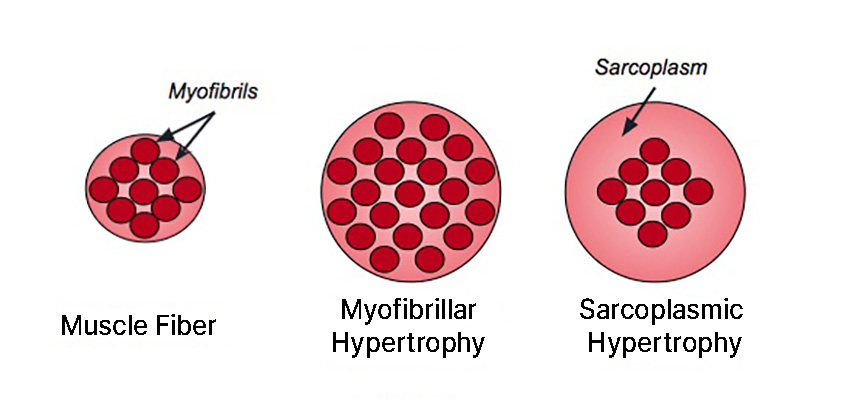
For a more in-depth look at the muscle’s anatomy and physiology of building muscle, check out Part 1 of this article series.
We desire both types of hypertrophy when our goal is to build muscles.
It’s important to note you can’t separate these two types of hypertrophy. They both occur when you workout. But you can put more emphasis on one of these types.
Lifting heavier weights with fewer repetitions stimulates myofibrillar hypertrophy. This makes us stronger for our size. Think powerlifters with this type of hypertrophy.
Lifting lighter weights with more repetitions activates more sarcoplasmic hypertrophy. Think bodybuilders here.

Myofibrillar and sarcoplasmic hypertrophy stimulate the two types of muscle fibers in our skeletal muscles, fast and slow twitch muscle fibers.
Fast twitch fibers generate a powerful force but fatigue quickly. Slow twitch muscle fibers are fatigue resistant and have greater endurance. The slow twitch fibers have more blood vessels than fast twitch fibers and are more aerobic.
Both fibers work during exercise. Sarcoplasmic hypertrophy stimulates slower twitch fibers, and myofibrillar hypertrophy stimulates faster twitch fibers. (1)
Since we want to maximize overall muscle mass, our goal is to hypertrophy all our muscle fibers. This means training for strength (fast twitch fibers) and work capacity (slow twitch fibers).
Hypertrophy training is the best of both worlds. It combines strength and work capacity training to help us put on the most muscle possible.
A hypertrophy program doesn’t have to focus on power like a powerlifting or athletic program. Nor does it have to focus on developing more fast or slow twitch fibers. With muscle size as our goal, we can concentrate on techniques that give us the most muscle size.
Benefits Of Bigger Muscles

Having bigger muscles also gives us advantages other than looking attractive. These advantages include the following:
- Overall Health: Bigger muscles help improve cardiovascular health, manage your blood sugar, build bone density, and can reduce the risk of all-cause mortality. (2, 3, 4)
- Strength: Bigger muscles have a greater potential to develop strength. This is why athletes and powerlifters incorporate hypertrophy training into their workouts.
- Athleticism: You can generate more explosive power and momentum with bigger muscles. Olympic lifters and athletes depend on this athleticism and train for muscle size.
Hypertrophy training provides a balanced way to improve your strength, athleticism, and work capacity – along with the most important result, building muscle.
The following sections will cover the ABCs of hypertrophy training, including guidelines to help you incorporate hypertrophy training into your workouts.
Training Volume
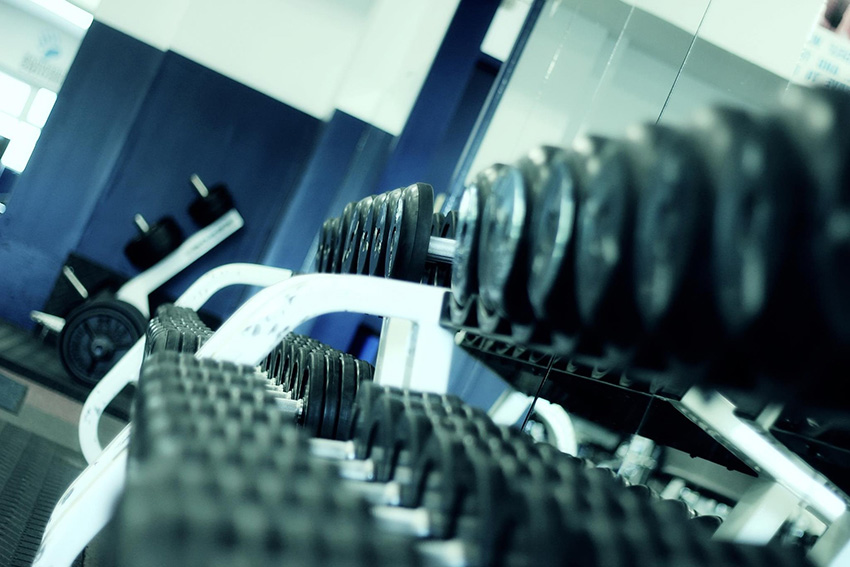
Ask ten people at your gym how many sets and reps you should do for any exercise and you’ll get a different answer each time.
Training volume has been a contentious topic in the fitness industry. If this is a highly debated topic, how do you know the training volume needed for muscle growth?
Instead of designing your workout based on unsupported opinions and rules of thumb, this article uses the considerable research on training volume to give you evidence-based recommendations that will make your workouts more effective.
Below, we cover everything you need to know about training volume for muscle growth.
What is Training Volume?
Implementing the correct training volume is crucial for building muscle with hypertrophy training.
You can break down muscle fibers and start the muscle-building process with the correct training volume. The components of training volume are:
- Reps: Reps or repetitions are the number of times you complete a single exercise before taking a rest or break.
- Sets: The completion of several reps in a row of a specific exercise.
- Weight: How heavy the weight is for the exercise you’re performing
The general definition of training volume is the total amount of work performed during a training session or program.
The formula often used to calculate volume is: Volume = sets x reps x weight.
For example, if we did bench press for 6 sets for 10 reps at 200 lbs, our volume for bench press would be 12,000 lbs. This will give us the total lbs lifted in a workout or the total amount of work we do.
While this is a useful and practical definition of volume, it is not ideal if our goal is muscle growth. We don’t care how much work we are doing in a workout. Our only concern is how much muscle growth we are stimulating.
We can then define training volume as the total number of challenging sets performed.
Challenging sets stimulate muscle growth regardless of the amount of work we do. So counting the number of hard sets performed is a better metric than the overall work performed.
For example, if we did 6 hard sets of lat pull-downs on Monday and 4 on Thursday, our weekly training volume is 10 hard sets.
Okay, now for the moment you’ve been waiting for. Science-based recommendations for the ideal volume for building muscle.
You Need Challenging Sets For Your Muscles To Grow
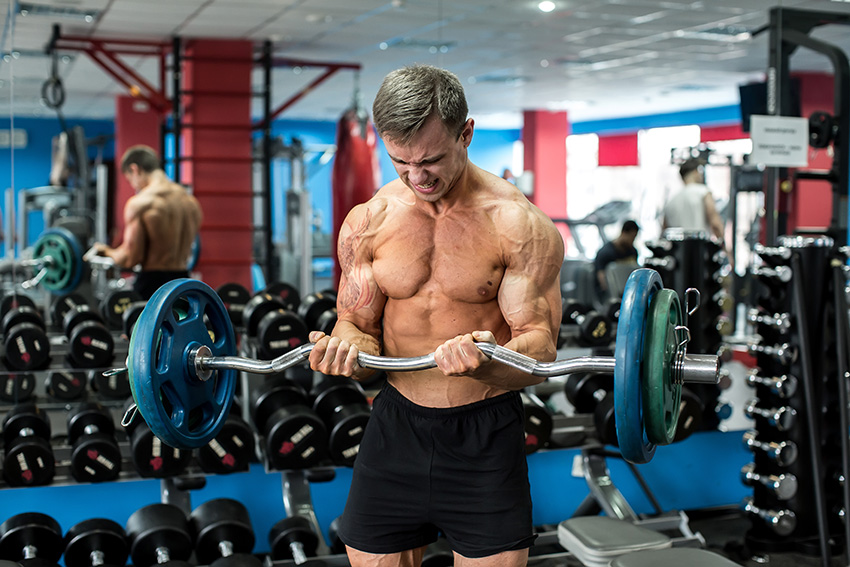
The metric used for muscle growth training volume is challenging sets.
Strongman, Nathan Jones, popularized the idea of using challenging sets. (5)
To reap the full benefits of muscle growth, the sets performed need to be challenging. Challenging sets are sets that:
- target the specific muscle that you want to grow
- use a full range of motion for the exercise
- contain enough reps to stimulate max muscle growth
- bring sets 1 to 2 reps before failure
Don’t worry. Throughout this article, we’ll explore the different aspects of challenging sets. Just know you need to be training hard to see results, especially if you are an intermediate or advanced lifter.
How many sets should I do to build muscle?
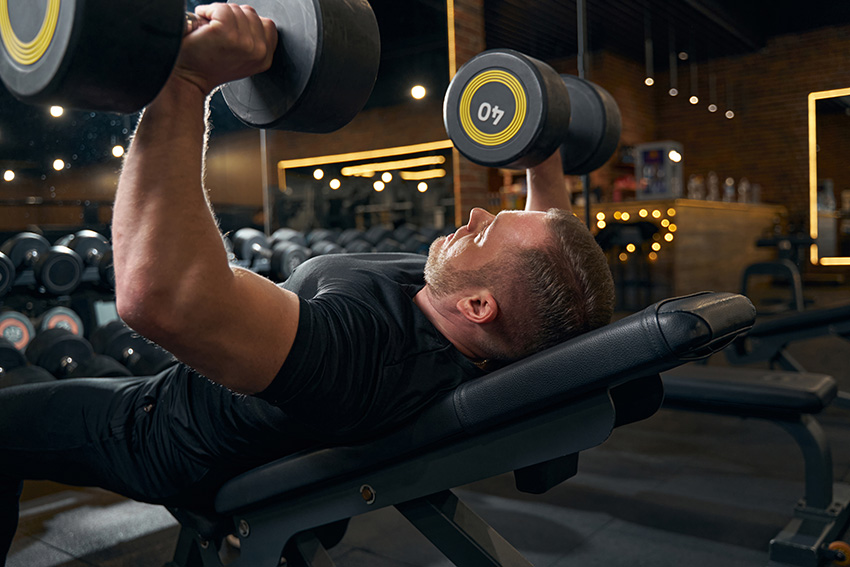
Finding the perfect amount of sets for max muscle growth is not an exact science.
Many variables can affect the number of sets required for muscle growth. These variables include your body’s ability to recover from workouts, your workout frequency, how much weight you are lifting, and your overall fitness level.
Two of the leading volume experts, Mike Israetel and James Krieger, developed a framework for the sets you need to build muscle. Based on their research, we can conclude the following: Do 9-18 weekly sets per muscle group to maximize muscle growth. (6, 7)
To understand how we arrived at this 9-18 set range, let’s look at both studies individually.
The article Training Volume Landmarks by Dr. Israetel specifies the ideal weekly sets for maintaining and building muscle. Here is a summary of his research for the sets needed to build muscle for each muscle group:
- Chest: 6-35 sets per week. A mix of horizontal and incline pressing and isolation movements that don’t involve the triceps is ideal.
- Back: 10-35 sets per week. Your back comprises many different muscles, so you should focus on horizontal movements (rows), vertical movements (lat pull-down machine), and pulling movements.
- Traps: 0-40 sets per week. You can build trap muscles without direct trap work by deadlifting, rowing, and training your rear delts. You can add additional sets of direct trap work to increase their size.
- Front Delts: 0-16 sets per week. Front delts get a lot of stimulation from chest movements and overhead presses. Volume doesn’t need to be high to grow your front delts.
- Side Delts: 8-40 sets per week. Side delts get little stimulation from your training and recover fast. This allows you to perform high weekly sets.
- Rear Delts: 6-35 sets per week. Rear delts also recover very quickly and can take higher volumes.
- Biceps: 8-30 sets per week. Back movements stimulate your biceps. The less back work you do, the higher your sets can be for the biceps.
- Triceps: 6-30 sets per week. Shoulder movements, especially chest movements, stimulate the triceps. To fully develop them, you need at least six sets per week.
- Forearms: 2-25 sets per week. Every time you grip something, you use your forearms. If you want to develop them further, do wrist curls and wrist extensions.
- Quads: 8-30 sets per week. Squats, hack squats, and leg presses work well for muscle growth. Squats can be very fatiguing for your body. Determine the number of sets for this large muscle group based on your recovery.
- Hamstrings: 4-18 sets per week. Exercises that hinge at the hip (stiff-legged deadlifts, good mornings) and leg curls are ideal.
- Glutes: 0-30 sets per week. You can make glute gains if you squat, deadlift, and do other quad and hamstring work. Add hip thrusts and glute bridges to fully stimulate your glutes every week.
- Calves: 8-30 sets per week. Combine seated and standing calf raises for full development.
- Abs: 0-25 sets per week. Compound lifts help stimulate your abs and maintain them. If you want bigger abs, train them directly.
As you can see, Dr. Israetel recommends 6–40 sets per muscle per week, spread out over 2 to 6 workouts. This is quite a high set range for some of the muscle groups. It can be beneficial to venture into these higher set ranges if you have a lagging body part or have reached a plateau in strength.
For most people, somewhere in the middle of these set ranges yields the best results. This research is the basis for our recommendation that most people do 9-18 weekly sets for each muscle group.
To perform higher set ranges, you must build up to them in your training cycles. You should only sustain high-set workouts for one or two weeks or until you are unable to recover between workouts, according to Dr. Israetel.
Also, Dr. Israetel recommends reducing the number of sets you do for other exercises once you reach the upper limits. This will give your body a better chance to recover from the higher volume added to the targeted muscle groups. Decide which muscles you want to grow the fastest and prioritize them.
After a week or more of high sets, you must have a “deload” week where you perform the fewest sets possible to let your body recover from the high volume.
Dr. Israetel recommends dividing your weekly targeted volume between workouts. It’s ideal to perform 4-12 sets per session. Breaking up your volume gives your body time to recover from the workouts.
Reduce your sets if you aren’t recovering from your high-set workouts. Other factors could affect your body’s ability to heal, like your sleep and nutrition.
Let’s now have a look at James Krieger’s study. (8)
This study analyzed fifteen of the most relevant volume and muscle growth studies. He concluded that you must train each muscle group 12-18 sets a week to achieve maximum muscle growth. You also need to train each muscle 2-3 times weekly for 6 sets every workout.
The recommended weekly sets however can change depending on your rest periods and training frequency. We’ll cover the ideal rest times and training frequency later in the article.
There are two instances in which Krieger says doing more volume can result in greater muscle growth. These two situations are when you are volume cycling or bringing up lagging body parts. As explained below, Dr. Israetel recommendsadding more volume in these situations.
Volume Cycling
A training cycle can begin with low volume and progress to higher volume beyond 18 sets a week. According to Krieger, you shouldn’t train with high volume for more than two weeks.
Volume cycling can increase muscle growth. But the effectiveness of volume cycling needs to be further researched.
Lagging Body Parts
You can increase the number of sets for a particular body part if you want to bring it up faster. To give your body the best opportunity to recover, remove the volume from other exercises when adding this extra volume.
The bottom line to all this research is that 9-18 sets spread out over 2-3 workouts per week are ideal for most people to build muscle.
The key here is to experiment within these ranges to find out what creates the most growth for you. Start with the lower end of the set ranges. Once you have found the number of sets that build muscle, stick with that set range.
When should I increase the sets?
You should gradually increase the number of sets per week when you:
- aren’t gaining strength from week to week
- don’t get sore after workouts
- have a hard time getting a pump
For example, let’s say you are doing bench press for 3 sets 2x a week for a total of 6 weekly sets.
For 3 weeks, you make significant progress. In the fourth week, you aren’t sore after the workout and have difficulty adding more weight to the bar. You can now add a 4th set to try and break through this plateau.
When you plateau, add sets until you have difficulty recovering between workouts.
When you aren’t able to recover from high-set workouts, add in a deload week to give your body a rest. After the deload week, you can begin a new workout cycle with different exercises, changes in reps, or both.
How many reps should I do to build muscle?
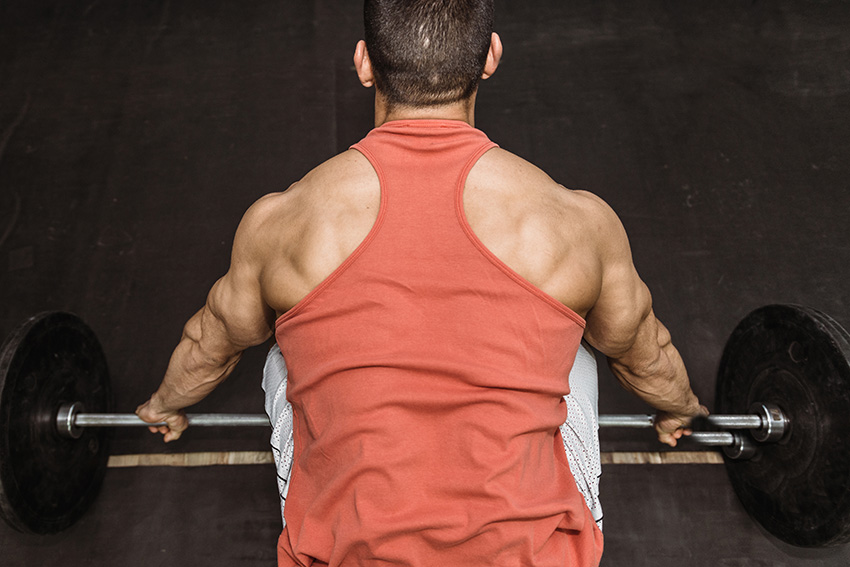
Between 6 and 20 reps per set is ideal for building muscle. (9)
If the reps are too low or too high, you won’t stimulate muscle growth as effectively. (10, 11)
Why can’t I build muscle with a higher rep range?
You can build muscle with higher rep ranges, but it can be challenging. With higher reps, you will need to use lighter weights, or you won’t be able to perform 20+ reps.
Lifting lighter weights requires you to take your sets to failure to stimulate maximum muscle growth. High rep sets increase your work capacity and conditioning but strain your cardiovascular system. You’ll often reach cardiovascular failure before you can come close to muscle failure.
High rep ranges also cause a greater build-up of lactic acid. This lactic acid build-up causes an intense burning sensation. This build-up of lactic acid will make pushing your sets to failure difficult.
If you don’t want to feel winded after every set or vomit during your workout to build muscle, stick to the 6 to 20 rep range.
What about lower rep ranges from 1 to 4 for building muscle?
You can build muscle with rep ranges from 1 to 4.
Strength and hypertrophy training build a similar amount of muscle when you lift the same overall amount of weight. (12, 13, 14)
Lower rep ranges require heavier weights to perform challenging sets that build muscle.
The problem with lifting heavier weights in this lower rep range is you’ll be lifting less weight per set.
For example, if you do 4 reps with 50 pounds, you’ll lift 200 pounds per set. If you do 10 reps with 30 pounds, you’ll lift 300 pounds. That’s 50% more weight lifted with lighter weights. Also, heavier weights are tougher on our bodies.
This increased stress on our bodies makes it challenging to perform the required sets for optimal muscle growth.
With the moderate rep range of 6 to 20 reps, you can stimulate much more growth per set and finish the workout sooner. You can also add more exercises to gain muscle with a reduced workout time.
When should I use lower reps?
Lower rep ranges are ideal for strength training and increasing your 1-rep max. (15)
Lower reps help your muscle fibers adapt to one all-out rep. The lower rep ranges allow your body to activate more motor neurons and contract your muscles. This makes you stronger.
Hypertrophy training is the best of both worlds. It combines strength and work capacity training to help us put on the most muscle possible.
Should I take my sets to failure?
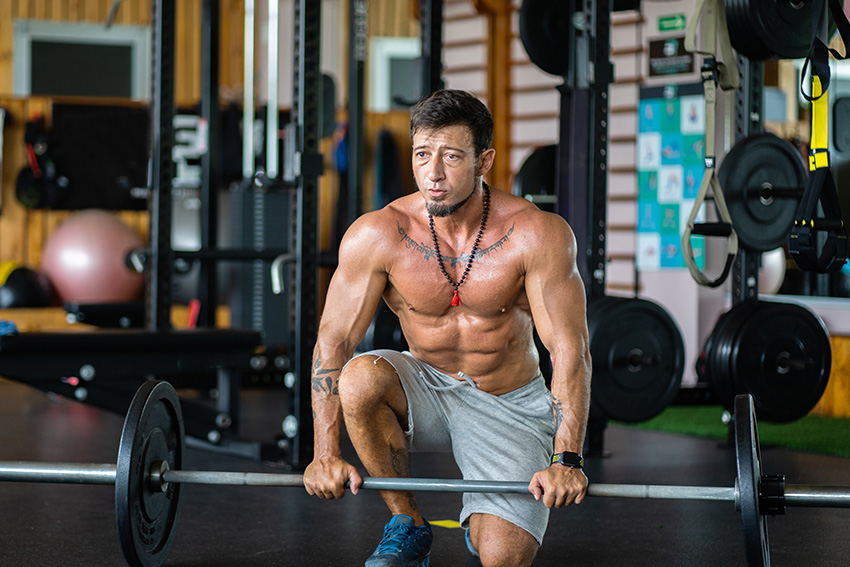
There are numerous definitions for training to failure. We are only going to focus on the definition that suits hypertrophy training.
When training for muscle size, “technical failure” is what we want. Technical failure is when you can no longer lift the weight with proper form.
For a standing bicep curl, technical failure occurs when a person cannot complete a rep without swinging the weight.
There has been a great deal of research done on training to failure. Let’s take a look at some of the results from the most popular studies.
To fully stimulate your muscles, you should bring your sets one to two reps before failure within the recommended 6-20 reps. Depending on how safe the lift is, you can take the final set of each exercise to failure. (16, 17)
To maximize muscle growth, let’s dig deeper into training to failure. Our fitness level, the type of lift performed, and the rep range will determine if we should lift to failure.
Let’s break down each variable to see whether you should train to failure.
Fitness level
- Beginners: Lifters just starting should lift to failure. As a beginner, you won’t be able to recruit as much muscle as seasoned lifters. So going to failure helps stimulate more growth. Beginners should only take isolation lifts to failure for safety reasons.
- Intermediate & Advanced: By stopping 1 to 2 reps before failure, seasoned lifters will stimulate more growth.
Type of Lift
- Compound lifts: you stimulate maximum muscle growth by stopping 2 reps before failure. You also reduce your risk of injury by not taking these lifts to failure. The following are compound lifts: bench presses, squats, deadlifts, and barbell rows.
- Isolation lifts: you can stimulate more muscle growth by stopping right before failure. The smaller isolation lifts aren’t as taxing on the body as compound lifts and are safer to perform. You can take your last set of isolation exercises to failure. The following are isolation lifts: bicep curls, leg extensions, and lateral raises.
Rep Ranges
- Lower rep ranges: stopping right before failure is the best way to stimulate muscle when lifting heavy weights in the 1-6 rep range.
- Higher rep ranges: you stimulate the most muscle when lifting lighter weights in the 15-20 rep range.
Use these recommendations to make the best choice for your workouts.
Looking for an even more comprehensive article on Training To Failure? Check out Training to Failure: 5 Questions You Need to Answer.
How long should I rest between sets?

Rest times don’t matter for muscle growth. (18)
The primary catalyst for muscle growth is training volume. You can get the same muscle growth with long and short rest periods. (19)
But there are pros and cons to each rest interval.
Long Rest Periods
Long rest intervals, 3 to 5 minutes, are best for gaining maximal strength.
The more extended rest periods allow you to regain your strength. If you don’t regain your strength, you won’t be able to put as much mechanical tension on your muscles (won’t be able to use the heavier weight). Your diminished strength makes the set less efficient.
Another benefit of longer rest intervals is to help avoid overtaxing your cardiovascular system. Reaching cardiovascular failure before muscle failure during a set prevents optimal muscle growth.
When using longer rest periods, “Rest until your breathing has returned to normal,” says Mike Israetel, author of Scientific Principles of Hypertrophy Training. This extended rest period will most likely be within the 3 to 5 minute range but sometimes longer than 5 minutes.
Short Rest Periods
Short rest periods, 1 to 3 minutes, are best for working on conditioning. Other benefits of shorter rest intervals include:
- Doing more sets in less time
- Improving your work capacity
- Storing more fuel in your muscles
- Keeping a healthy cardiovascular system
So what rest intervals should you use in your training?
Use a combination of long and short rest periods between sets within a single workout.
Using long and short rest periods in the same workout gives you the benefits of both. You can build muscle, gain strength, and improve your health.
When combining short and long rest periods in a workout, long rest intervals are better for compound lifts, while short rest intervals are better for isolation lifts.
Progressive Overload
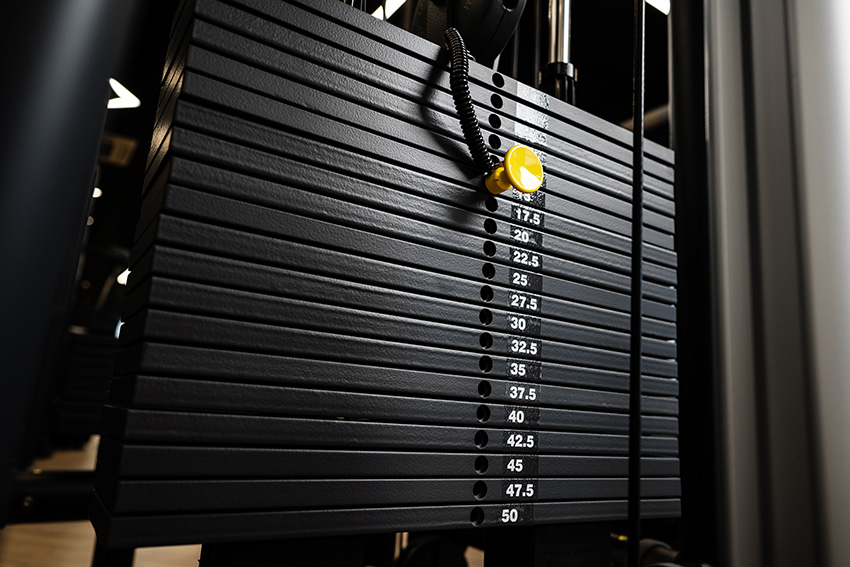
No guide on hypertrophy training would be complete without talking about progressive overload.
Progressive overload builds stronger and bigger muscles in hypertrophy and strength training. Implementing progressive overload makes workouts more challenging over time by stressing your musculoskeletal (bones, muscles, tendons, ligaments, and soft tissues) and nervous systems.
You can only become bigger and stronger when you challenge your muscles. Your body never changes if you perform the same exercise with the same weight, sets, and reps. Keeping these variables constant will keep you from progressing and you’ll plateau.
Using progressive overload in your workouts prevents you from hitting a plateau.
You might think the only way to challenge your muscles is to add more weight to the bar.
But, you can progressively overload your body in numerous ways to become bigger and stronger. Here are the five ways to progressively overload your musculoskeletal and nervous systems.
- Add more weight
Adding more weight is the most common way to progressively overload your muscles. Add weight in small increments over time to challenge your muscles.
- Add more reps
Sometimes, you won’t be able to add more weight to your exercises. By challenging your work capacity, you can still stimulate muscle growth.
Do this by adding more reps to your exercises within the ideal hypertrophy rep range of 6 to 20.
Adding more reps is best for smaller muscle groups when adding even 5 lbs might be too heavy to perform 6 reps. Bicep curls, rear delts, and lateral raises are exercises that benefit from rep progressive overloading.
Adding reps increases the time under tension, which also leads to muscle growth. (20)
- Add more challenging sets
Performing more challenging sets also increases volume and helps build muscle.
Progressively overload muscle groups by gradually adding more challenging sets within the 9-18 weekly set range.
- Workout frequency
Another great way to implement progressive overload is to add another workout for the muscles you are trying to build.
Stay within the recommended 2 to 3 workouts a week per muscle group.
- Combinations of more weight, reps, sets, and workouts
You can use a combination of weight, reps, sets, and workouts to build more muscles and get stronger. You aren’t limited to manipulating one variable.
Try experimenting with different combinations to see what works best for you. Remember to stay within this guide’s hypertrophy rep, set, and workout ranges.
Implementing Progressive Overload in Your Workouts
You should try to one-up your previous workout each time by using one of the five progressive overload methods mentioned above.
The keyword here is “try.”
Building muscle and strength is not linear. If you are pushing your body’s limits every workout, you won’t be able to recover, and you’ll fatigue.
When recovery is an issue, you won’t be able to add more weight, sets, and reps to every subsequent training session. Building muscle and strength through progressive overloading will not be possible until your body has recovered.
You need to be patient when building muscle.
Think about it this way.
If you add 10 lbs to your squat every month for 6 months, you’ll lift 60 lbs in only half a year. That is a lot of weight added to your squat.
Progress will be slow, especially if you are an intermediate or advanced lifter.
Beginning lifters can see progress on every workout. Their bodies aren’t used to the stress and they can adapt rapidly. So beginners can add that extra 5 lbs. to their bicep curl, eke out another rep, or add more sets from week to week to a certain point.
Intermediate and advanced lifters have a more challenging time gaining size and strength. Building muscle becomes even harder when people are closer to their genetic potential. You need to train smart to build strength and size through progressive overload.
Are you having a hard time recovering from your workouts?
Do one of the following:
- take a few extra rest days
- take a week off
- Have a “deload” week where your decrease the intensity and volume
More weight, more reps, and more sets are not always the answer.
Sometimes your body just needs a break. You won’t lose all your gains if you take a week off. Listen to your body and take time off if needed.
For a deeper dive into the recovery process, check out article four of this guide.
How Heavy Should I Lift?
When it comes to building muscle, the weight doesn’t matter.
Yep, you read that right. It doesn’t matter.
To build muscle effectively, you need to choose a weight that does the following:
- Takes the set within 1 to 2 reps of failure in the recommended hypertrophy 6-20 rep range.
- Allows you to perform the set with good form
- Allows you to get a strong muscle contraction
- Won’t put you at risk of injury
It is all too easy to get caught up in lifting heavier weights than you can handle.
Your workout partner might be lifting heavier, and you want to keep up. You see a bunch of bodybuilders lifting heavy on YouTube, inspiring you to lift heavier.
Everyone has a different level of fitness. You shouldn’t use other people as a barometer for how heavy you should lift.
Choose a weight that challenges your muscles within the hypertrophy volume ranges. Lifting a heavier weight than you can handle will not help you put on more size. You won’t fully develop your muscles and you’ll run the risk of serious injury.
And guess what. If you’re injured, you can’t workout, and you can kiss your gains goodbye.
How Frequently Should I Train?

Our goal is to build muscle as effectively and quickly as possible. So as soon as the muscle recovers, we want to work it out again.
Exercising stimulates muscle growth for a specific time frame after completing a workout. We use this time frame to help determine when we should train again.
Three popular studies show that different set ranges stimulate muscle groups for 1-3 days and sometimes even longer. (21, 22, 23)
We aim for 6 to 9 sets per muscle group per workout. According to these studies, this number of sets will stimulate 2-3 days of muscle growth.
The research suggests training each muscle group at least twice a week for maximum muscle growth. (24)
We can further support this claim by examining a meta-analysis of 10 studies on training frequency from muscle hypertrophy expert Brad Schoenfeld. (25) The research shows you can build muscle faster when you work your muscles two or more times per week.
But this is not an exact science.
Giving your muscles two or three days to recover doesn’t mean they are fully recovered and ready for another workout. You may still feel fatigued and your muscles might still be sore.
Here are some of the main training variables that affect your ability to recover (26)
- Experience level
- New workouts
- Size of the muscle trained
- Volume
- Taking sets to failure
Your experience level is one of the key factors in recovery., If you are a beginner, you may be sore for 4 or 5 days after a workout because your body isn’t used to the stress. Even if you are an intermediate or advanced lifter you maybe sore for more than 3 days when you try a new workout.
Also, the muscle worked can have its own recovery timetable. Bigger muscle groups will have a longer recovery period than your smaller muscles. So your quads will take longer to heal than your rear delts or biceps.
By the way, if you are looking for a great article on how to build your arms, then you have to check out this article on the Best Arm Exercises of All Time.
Will my body be able to recover if I workout my muscles 2-3 times a week?
As we progress in our training, we become stronger. The increased strength allows us to workout more frequently. Eventually, our workouts won’t cause as much muscle damage.
Spreading the recommended weekly training volume of 9-18 sets over two to three workouts reduces fatigue.
The distribution of sets lets us do more reps and lift more weight.
So how often should I train my muscles?
You generally want to workout your muscles 2 to 3 times per week.
In addition to the variables mentioned above, your training volume, and intensity can affect your ability to recover.
With a well-planned training split, your muscles will recover, and you can work them out 2-3 times a week.
Let’s now discuss the best training split for maximizing muscle growth.
What Training Splits Are Best For Building Muscle?
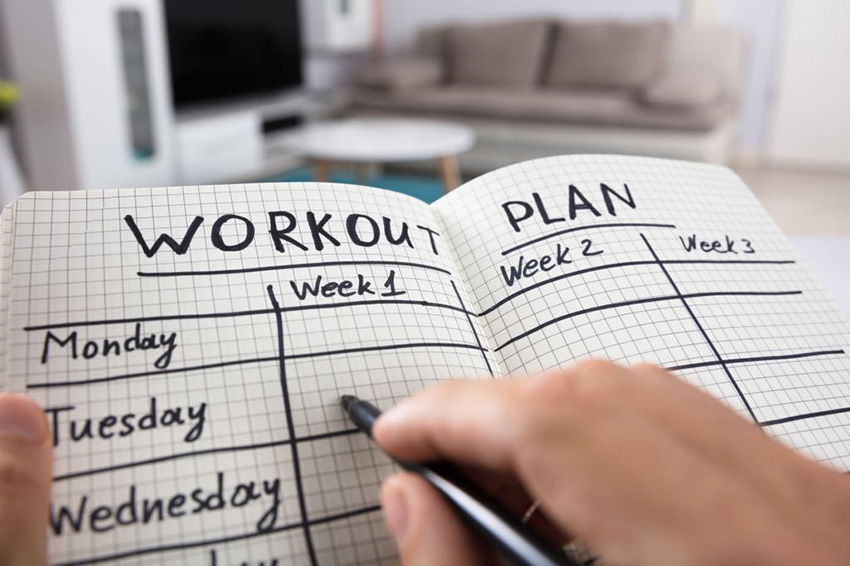
We have a lot of flexibility when designing a training split for muscle growth.
We’ll now cover four of the most popular muscle-building training splits. Included is a list of pros and cons for each to help you choose a training split that is right for you.
Full Body Workouts
As the name suggests, a full-body workout is when you train the entire body or most of the body in a single workout.
Full-body workouts focus on compound lifts to hit all your muscle groups. We’ll discuss why this is later in the article.
There are two versions of the full body workout, the 3-day and 2-day split. Here is what these splits look like.
2 Day Split
- Monday- full body
- Tuesday- off
- Wednesday- off
- Thursday- full body
- Friday- off
- Saturday- off
- Sunday- off
3 Day Split
- Monday- full body
- Tuesday- off
- Wednesday- full body
- Thursday- off
- Friday- full body
- Saturday- off
- Sunday- off
Pros of full body workout
- Great for strength- The full body workout emphasizes compound movements which are excellent for building strength.
- Plenty of rest- This split gives you plenty of time for your muscles to heal and grow.
- Effectively build muscle- A full body workout filled with compound movements stimulates all your muscles, allowing you to train them two to three times a week.
Cons of full body workout
- Hard to add frequency- Adding more frequency to your full-body workouts can be quite hard on your body. You are already performing many compound lifts that put a great deal of stress on your body.
- Longer workouts- As you become more advanced, you’ll need to add more sets and exercises. Your workouts will already be on the longer side, and adding more volume can make your workout too long.
- Not enough isolation movements- Isolation movements are integral for building muscle. There aren’t a lot of isolation movements in a full-body workout because it focuses on compound lifts.
Who should use full-body workouts?
If you can only dedicate two to three days a week to working out, this split will work for you. Need a full-body split program to get you started? Download one below!
Looking for even more ways you can get in exercise when you are short on time?
Check out 6 Creative Ways to Get More Exercise Daily When Short on Time.
Adding more frequency and volume can make your workouts lengthy and hard to recover from. These characteristics make the full-body split best for beginner and intermediate lifters.
Download Free Workout Splits ?️
Enter your name and email address and you’ll get access to 4 tried and tested workout splits.
Upper / Lower Split
This split divides your upper and lower body each workout. You’ll get plenty of leg training with this split and be able to add more volume.
Version 1
- Monday- upper body
- Tuesday- lower body
- Wednesday- off
- Thursday- upper body
- Friday- lower body
- Saturday- off
- Sunday- off
Version 2
For advanced lifters who want to hit their muscles three times a week.
- Monday- upper body
- Tuesday- lower body
- Wednesday- upper body
- Thursday- lower body
- Friday- upper body
- Saturday- lower body
- Sunday- off
Pros of upper/lower split workouts
- Shorter workouts- With more workouts to split up the volume, each session will be a little shorter.
- Add in isolation movements- splitting up the volume allows you to include more isolation exercises.
Cons of upper/lower split workouts
- Recovery- with this split, you’re exercising more frequently, and your body might not recover fully. Your legs, especially, may have a hard time recovering.
- More time in the gym- you’ll need to add an extra 1-3 days in the gym with this split.
Who should do upper/lower split workouts?
This split allows you to add more volume, and add more isolation exercises, but it can be hard to recover from. The upper/lower split works best for intermediate to advanced lifters.
Legs/Push/Pull Split
This split groups muscles that work together into one workout.
The push workout groups the chest, shoulders, and triceps together in a single workout. The pull workout groups together the back and biceps. The leg workout includes your glutes, hamstrings, quads, and calves.
This split works each muscle group twice a week.
- Monday- legs
- Tuesday- push
- Wednesday- pull
- Thursday- off
- Friday- legs
- Saturday- push
- Sunday- pull
Pros of legs/push/pull split workouts
- Muscles are trained equally- the three workouts split up your muscle groups and allow you to train your muscles equally.
- Workouts are shorter- dividing your muscle groups between workouts lets you spread the volume throughout these workouts.
- Add in isolation movements- The increased number of weekly workouts allows you to add in isolation movements.
Cons of legs/push/pull workouts
- 6 days in the gym- This split has you in the gym the longest by adding an extra 1 to 3 days compared to the other splits.
- Recovery- you might have a hard time recovering from workout to workout.
Who should do the legs/push/pull split workouts?
You are in the gym almost every day with this split. You train each muscle group equally, but recovery can be an issue. These factors make the split ideal for advanced lifters trying to develop their entire physique.
Alternative Splits
Many other splits incorporate the right volume for hypertrophy beyond the three mentioned above.
Any split that trains your muscles 2 to 3 times a week and includes 9-18 sets per muscle group will be effective for building muscle.
Based on your workout experience and the lifestyle you want to live, you can choose from one of the splits I’ve presented or create your own.
Need some ideas for alternative splits? Download my current split below.
Download Free Workout Splits ?️
Enter your name and email address and you’ll get access to 4 tried and tested workout splits.
Muscle Building Exercises

There are many factors to consider when choosing exercises for muscle growth. Let’s break down each one to help you find the best exercises for building muscle.
Compound Lifts vs. Isolation Lifts
Developing a balanced physique requires both compound and isolation exercises.
Compound lifts are exercises that work multiple muscle groups simultaneously. Think squats, deadlifts, and bench presses. Isolation lifts are exercises that work a single muscle group. Think bicep curls, tricep pushdowns, and hamstring curls.
Compound lifts are an excellent choice for muscle mass because they allow you to
- Stimulate large amounts of muscle
- Put tension on the muscles
- Progressively overload your muscles
- Perform a deep range of motion
Compound lifts engage the most overall muscle mass and have all the essential muscle-building attributes. These attributes make compound lifts an excellent choice for filling out most of a hypertrophy program.
If compound lifts are great for building muscles, why do we need isolation lifts?
With only compound lifts, you can develop all your muscles, but not equally.
Compound lifts work specific muscles harder, while other muscles serve as stabilizers.
A study of chest and triceps growth shows the imbalance created by compound lifts. The study measured muscle growth after doing different combinations of bench press and skull crushers (lying tricep extensions). (28)
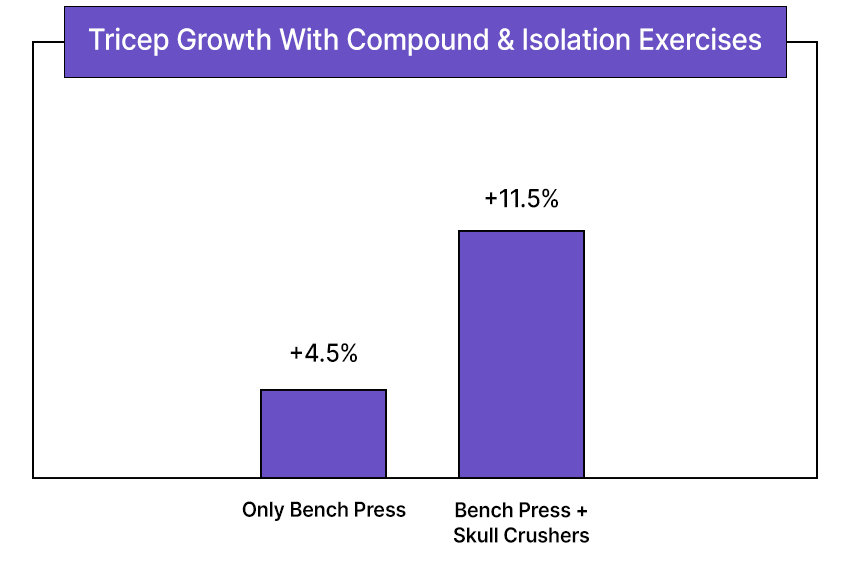
When bench presses were the only exercise performed, the chest grew almost twice as much as the triceps.
The chest and triceps grew similarly when skull crushers were added with the bench presses. This imbalance highlights another issue with only using compound movements in your workouts.
Compound movements don’t train all the movement patterns of every muscle. Some muscles have multiple movement patterns as they cross more than one joint.
Training a muscle’s different movement patterns is essential for its full development.
Compound movements might only train one of these movement patterns, leading to underdevelopment.
Let’s look back at the bench press and skull crusher study. Now we can see why only using bench presses to build your triceps isn’t ideal. The triceps have two functions: extending the elbow and contracting the shoulder.
During the bench press, you extend your elbow but don’t contract your shoulder. To contract your shoulder during a bench press, you must let your elbow bend and travel closer to your head. I would not recommend this as it can be very dangerous.
When we combine skull crushers with the bench presses, we can fully develop the tricep. We can work the movement pattern of the long head that extends the elbow and contracts the shoulder.
This study shows the value of isolation exercises.
Most all your muscles will grow with compound movements, but some at a slower rate. It is up to you which muscles you want to develop.
Later in the article, I’ll discuss isolation exercises you can do for each muscle group to develop them fully.
Free Weights Vs. Cables Vs. Machines
Free weights, cables, and machines stimulate similar amounts of muscle growth. (27)
By adding these three types of exercises to your workout routines, you can stimulate more muscle growth. Each exercise uses a different movement pattern to break down muscle fibers. The variety of exercises will constantly challenge your muscles and promote muscle growth.
This constant challenge to our muscles is the true driver of muscle growth.
Exercise variety also reduces joint pain by reducing the stress caused by many repetitions of the same exercise.
Let’s now cover compound and isolation lifts for building your physique.
Deep Stretch, Full Range Of Motion, & Tension
We must also choose exercises that challenge our muscles in a deep stretch to build them.
This deeper stretch will allow us to perform the exercise with a full range of motion. The deep stretch will put the necessary tension on the muscles to break down as many muscle fibers as possible.
Challenging our muscles in a deeper range of motion can stimulate 2 to 3 times more muscle growth than in a smaller range of motion. (29, 30, 31, 32)
In this deep stretch, we can put two types of tension on our muscles, active and passive tension. Active tension is the tension created from the muscle’s actual contracting. The stretching of your muscles creates passive tension.
Combining these two tensions puts greater stress on our muscles and stimulates their growth.
This mechanical tension is one of the key components of building muscle. Active tension alone isn’t enough to fully stimulate your muscles. You must also have passive tension. (33)
Now you can see how hypertrophy training differs from other types of training.
With athletics, the focus is on explosiveness and power. Powerlifting is all about your 1 rep max.
When building muscle, we want to tax the muscle heavily through a deep stretch, full range of motion, and tension. Exercises that contain these characteristics break down muscle fibers most efficiently.
Progressive Overload
To build muscle, you must choose exercises that progressively overload and challenge your muscles. Selecting exercises that allow you to use heavier weights, add more reps, and use a deep range of motion is important.
With free weights, cables, and exercise machines, you can progressively overload your muscles and put on size.
Let’s move on to the final component of what makes an exercise excellent for muscle growth.
So what exercises build muscle?
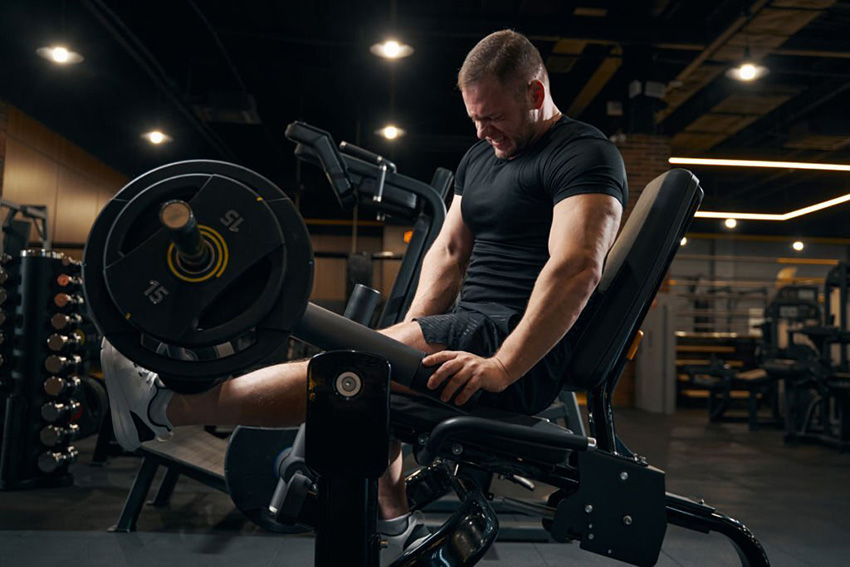
Okay. so now you have the basics and here’s how to apply them. We now know what to look for in an exercise to build muscle.
So what compound and isolation exercises should you perform for maximum muscle growth?
Below is a list of compound and isolation exercises you can include in your workout program to fully develop your physique.
Compound Movements
- Squats- back squat, front squat, safety bar squat, hack squat, and goblin squat
- Deadlifts- conventional and sumo deadlifts, Romanian deadlifts
- Presses- flat bench press, incline bench press, narrow grip bench press, shoulder press, dips (weighted), leg press
- Pulls & Rows- overhand & underhand lat pulldowns, pullups, barbell and dumbbell row
Isolation Movements
- Quads- leg extensions, split squat, and Bulgarian split squat
- Hamstrings- lying, seated, and standing leg curls, lunges
- Glutes- hip thrusts, kickbacks
- Chest- dumbbell or machine fly, cable crossover
- Back- straight arm lat pull-down, pullover
- Traps- shrugs, face pull
- Biceps- barbell curl, dumbbell curl, incline curl
- Triceps- tricep pushdown, overhead extension, skull crushers
- Side Delts- lateral raises, upright row
- Rear Delts- rows, reverse fly, upright row, face pull
- Calves- seated and standing calf raises
- Abs- crunches, leg raises
In no way is this a definitive list of all the muscle-building exercises. This list contains foundational exercises to help you start building your workouts. I didn’t include all variations for machine, dumbbell, and cable exercises as there are too many to list.
If your goal is to build muscle, there are no mandatory exercises.
You are free to choose any of these exercises you want. You can pick another variation if you have joint pain on any exercise. If you feel a better contraction on a bicep curl machine, use that instead of a barbell. But be sure to include compound and isolation exercises if you can perform them.
Want a free workout program that you don’t have to create?
Download free workout programs that incorporate everything we discussed in this guide from the form below.
Download Free Workout Splits ?️
Enter your name and email address and you’ll get access to 4 tried and tested workout splits.
This free download includes standard workout programs for each split we discussed. It also contains reps and sets.
These workout programs will help you develop a balanced and complete physique.
Are you looking to build muscle as fast as possible?
Everyone’s body is different.
Custom workout and nutrition plans are the most effective for making progress in the gym. If you want to lose fat and put on muscle, I create custom workout and nutrition plans based on your goals.
By combining my personal experience with the latest research on building muscle, strength, and fat loss, I can create a custom workout plan to help you develop your physique as quickly as possible.
Check out the Work With Me page and get a custom plan started now! (scroll down to the second option on the page).
How many exercises should I do for each muscle group?
There isn’t an exact number of exercises you should do for each muscle group to build maximum muscle.
The number of exercises you do depends on your ability to recover, your fitness level, and how many workouts you do per week.
We can use Dr. Israetl’s and Krieger’s research to find an approximate range for the exercises you should do each week.
Their research states that 9-18 sets per week spread out over 2-3 workouts is ideal.
Based on this recommendation, we want to perform 3-4 sets per exercise.
Get To Work!
Knowing how to workout for muscle growth doesn’t have to be a mystery. Using a muscle-building hypertrophy program ensures optimal muscle growth.
Experts in the fitness industry have done extensive research on hypertrophy programs. The research has resulted in the following guidelines on training for muscle mass:
- Train each muscle group 2 to 3 times per week
- Do 9-18 weekly challenging sets per muscle group
- Do 6-20 reps per set
- Take sets 1 to 2 reps before failure
These recommendations allow us to choose from a wide range of workout splits. Popular workout splits you can use include: full body, upper/lower body, and push/pull/legs.
When we choose exercises that put our muscles in a deep stretch, put tension on the muscle, and allow a full range of motion and progressive overload, we can stimulate muscle growth.
We need to perform compound and isolation movements to develop our physique fully. We can use free weights, barbells, or machines to accomplish this.
Anyone can build muscle with some planning, hard work in the gym, and adjustments to their training.
This takes us to the final article and pillar in this muscle-building series.
Don’t miss out on the most crucial piece to the muscle-building puzzle, recovery.
References
- Fry, Andrew C. “The role of resistance exercise intensity on muscle fibre adaptations.” Sports medicine (Auckland, N.Z.) vol. 34,10 (2004): 663-79. doi:10.2165/00007256-200434100-00004
- Stump, Craig S et al. “The metabolic syndrome: role of skeletal muscle metabolism.” Annals of medicine vol. 38,6 (2006): 389-402. doi:10.1080/07853890600888413
- Strength training builds more than muscles. Harvard School of Public Health. October 13, 2021. https://www.health.harvard.edu/staying-healthy/strength-training-builds-more-than-muscles
- Ruiz, Jonatan R et al. “Association between muscular strength and mortality in men: prospective cohort study.” BMJ (Clinical research ed.) vol. 337,7661 a439. 1 Jul. 2008, doi:10.1136/bmj.a439
- Jones, Nathan. The New Approach To Training Volume. May 12, 2015. https://www.strongerbyscience.com/the-new-approach-to-training-volume/
- Schoenfeld, Brad J et al. “Dose-response relationship between weekly resistance training volume and increases in muscle mass: A systematic review and meta-analysis.” Journal of sports sciences vol. 35,11 (2017): 1073-1082. doi:10.1080/02640414.2016.1210197
- Israetel, Mike Dr. The Hypertrophy Training Guide Central Hub. Nov 25, 2019. https://rpstrength.com/hypertrophy-training-guide-central-hub/
- Schoenfeld, Brad J et al. “Dose-response relationship between weekly resistance training volume and increases in muscle mass: A systematic review and meta-analysis.” Journal of sports sciences vol. 35,11 (2017): 1073-1082. doi:10.1080/02640414.2016.1210197
- Baz-Valle, Eneko et al. “Total Number of Sets as a Training Volume Quantification Method for Muscle Hypertrophy: A Systematic Review.” Journal of strength and conditioning research vol. 35,3 (2021): 870-878. doi:10.1519/JSC.0000000000002776
- Klemp, Alex et al. “Volume-equated high- and low-repetition daily undulating programming strategies produce similar hypertrophy and strength adaptations.” Applied physiology, nutrition, and metabolism = Physiologie appliquee, nutrition et metabolisme vol. 41,7 (2016): 699-705. doi:10.1139/apnm-2015-0707
- Schoenfeld, B J et al. “Effects of Varied Versus Constant Loading Zones on Muscular Adaptations in Trained Men.” International journal of sports medicine vol. 37,6 (2016): 442-7. doi:10.1055/s-0035-1569369
- Schoenfeld, Brad J et al. “Effects of different volume-equated resistance training loading strategies on muscular adaptations in well-trained men.” Journal of strength and conditioning research vol. 28,10 (2014): 2909-18. doi:10.1519/JSC.0000000000000480
- Klemp, Alex et al. “Volume-equated high- and low-repetition daily undulating programming strategies produce similar hypertrophy and strength adaptations.” Applied physiology, nutrition, and metabolism = Physiologie appliquee, nutrition et metabolisme vol. 41,7 (2016): 699-705. doi:10.1139/apnm-2015-0707
- Schoenfeld, B J et al. “Effects of Varied Versus Constant Loading Zones on Muscular Adaptations in Trained Men.” International journal of sports medicine vol. 37,6 (2016): 442-7. doi:10.1055/s-0035-1569369
- Schoenfeld, Brad J et al. “Differential Effects of Heavy Versus Moderate Loads on Measures of Strength and Hypertrophy in Resistance-Trained Men.” Journal of sports science & medicine vol. 15,4 715-722. 1 Dec. 2016
- Nuckols, Greg. The Evidence Is Lacking For“Effective Reps.” Sept. 9, 2019. https://www.strongerbyscience.com/effective-reps/
- Baz-Valle, Eneko et al. “Total Number of Sets as a Training Volume Quantification Method for Muscle Hypertrophy: A Systematic Review.” Journal of strength and conditioning research vol. 35,3 (2021): 870-878. doi:10.1519/JSC.0000000000002776
- Longo, Ariel Roberth et al. “Volume Load Rather Than Resting Interval Influences Muscle Hypertrophy During High-Intensity Resistance Training.” Journal of strength and conditioning research vol. 36,6 (2022): 1554-1559. doi:10.1519/JSC.0000000000003668
- Longo, Ariel Roberth1; Silva-Batista, Carla2,3; Pedroso, Kelly1; de Salles Painelli, Vitor1; Lasevicius, Thiago2; Schoenfeld, Brad Jon4; Aihara, André Yui5; de Almeida Peres, Bergson1; Tricoli, Valmor2; Teixeira, Emerson Luiz1,2. Volume Load Rather Than Resting Interval Influences Muscle Hypertrophy During High-Intensity Resistance Training. Journal of Strength and Conditioning Research: June 2022 - Volume 36 - Issue 6 - p 1554-1559 doi: 10.1519/JSC.0000000000003668
- Burd, Nicholas A et al. “Muscle time under tension during resistance exercise stimulates differential muscle protein sub-fractional synthetic responses in men.” The Journal of physiology vol. 590,2 (2012): 351-62. doi:10.1113/jphysiol.2011.221200
- Burd, Nicholas A et al. “Resistance exercise volume affects myofibrillar protein synthesis and anabolic signalling molecule phosphorylation in young men.” The Journal of physiology vol. 588,Pt 16 (2010): 3119-30. doi:10.1113/jphysiol.2010.192856
- Damas, Felipe et al. “Resistance training-induced changes in integrated myofibrillar protein synthesis are related to hypertrophy only after attenuation of muscle damage.” The Journal of physiology vol. 594,18 (2016): 5209-22. doi:10.1113/JP272472
- Miller, Benjamin F et al. “Coordinated collagen and muscle protein synthesis in human patella tendon and quadriceps muscle after exercise.” The Journal of physiology vol. 567,Pt 3 (2005): 1021-33. doi:10.1113/jphysiol.2005.093690
- Schoenfeld, Brad J et al. “Effects of Resistance Training Frequency on Measures of Muscle Hypertrophy: A Systematic Review and Meta-Analysis.” Sports medicine (Auckland, N.Z.) vol. 46,11 (2016): 1689-1697. doi:10.1007/s40279-016-0543-8
- Schoenfeld, Brad J et al. “Effects of Resistance Training Frequency on Measures of Muscle Hypertrophy: A Systematic Review and Meta-Analysis.” Sports medicine (Auckland, N.Z.) vol. 46,11 (2016): 1689-1697. doi:10.1007/s40279-016-0543-8
- Damas, Felipe et al. “A review of resistance training-induced changes in skeletal muscle protein synthesis and their contribution to hypertrophy.” Sports medicine (Auckland, N.Z.) vol. 45,6 (2015): 801-7. doi:10.1007/s40279-015-0320-0
- Schwanbeck, Shane R et al. “Effects of Training With Free Weights Versus Machines on Muscle Mass, Strength, Free Testosterone, and Free Cortisol Levels.” Journal of strength and conditioning research vol. 34,7 (2020): 1851-1859. doi:10.1519/JSC.0000000000003349
- Brandão, Lucas et al. “Varying the Order of Combinations of Single- and Multi-Joint Exercises Differentially Affects Resistance Training Adaptations.” Journal of strength and conditioning research vol. 34,5 (2020): 1254-1263. doi:10.1519/JSC.0000000000003550
- Maeo, Sumiaki et al. “Greater Hamstrings Muscle Hypertrophy but Similar Damage Protection after Training at Long versus Short Muscle Lengths.” Medicine and science in sports and exercise vol. 53,4 (2021): 825-837. doi:10.1249/MSS.0000000000002523
- Yanagisawa, Osamu, and Atsuki Fukutani. “Muscle Recruitment Pattern of the Hamstring Muscles in Hip Extension and Knee Flexion Exercises.” Journal of human kinetics vol. 72 51-59. 31 Mar. 2020, doi:10.2478/hukin-2019-0124
- McMahon, Gerard et al. “How deep should you squat to maximise a holistic training response? Electromyographic, energetic, cardiovascular, hypertrophic and mechanical evidence.” (2013).
- Sato S, Yoshida R, Kiyono R, Yahata K, Yasaka K, Nunes JP, Nosaka K and Nakamura M (2021) Elbow Joint Angles in Elbow Flexor Unilateral Resistance Exercise Training Determine Its Effects on Muscle Strength and Thickness of Trained and Non-trained Arms. Front. Physiol. 12:734509. doi: 10.3389/fphys.2021.734509
- McMahon, Gerard et al. “How deep should you squat to maximise a holistic training response? Electromyographic, energetic, cardiovascular, hypertrophic and mechanical evidence.” (2013).
